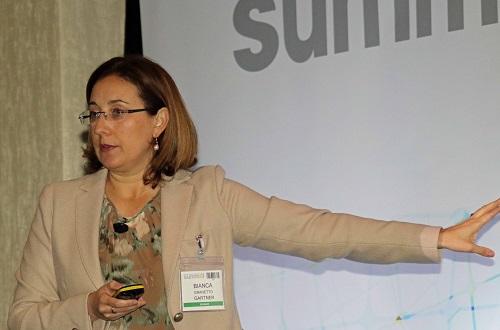
Key European managed services event hears Gartner expert on how the model is changing as customers find extra funds for IT transformation
Bianca Granetto (below), research director at Gartner says that digital business is all about redefining the buyer-seller relationship, and that in the longer term, the proportion companies spend on technology will rise. It is really about organisations transforming themselves, becoming more technology-focused, she told the European Managed Services Summit in Amsterdam on April 25. Technology becomes the lever by which the transformation happens, so is a core business for the organisation, which changes how the buyers see technology assets and changes the relationship with suppliers and the buying behaviour.

So there is a real call to action – sellers need to change as well and understand how technology works for customers and establish a new trusted relationship. Otherwise there will be a great gap with the seller community.
Where is the market today? “We know that the future of managed services will be very different as companies build their own technology positions.” From a managed services’ perspective, from now on it will be in a new managed services model, looking far deeper into organisations and supplying business change rather than technology.
Who buys IT now? “We know that organisations have CIOs and chief technology directors; we have added chief digital officer as analytics has emerged. So there are new roles that have to consolidate their positions. The CIO in the future will be different – with the first step being accountability, being accountable to the business as well as the CEO, responsible for much more, and more than IT services. The CFO role will also change, being in charge of the risk management model as it becomes digital, and needing to be much more aware of threats including cyber-threats when the business runs through on-line systems.”
Some have started the digital change, others have not done anything yet, but the issues are becoming apparent; this is scraping the tip of the iceberg. There is a lot of exploration and we are at the beginning of the wave, now about four years’ old.
The investment in this move is increasing, predominately driven by the CEO who needs to be innovative. For the rest of the company this is still work in progress. The reality is that digitalisation is not yet where we would like it to be and it needs to accelerate. On average, globally in industry, companies spend 3.5% of their revenues on IT – of this, some 70% is spent on running the business, and is locked in. 30% is partly to innovation and to projects to enhance the legacy systems. On average, they are spending 19% on digitalisation, but want to drive this to 28% by 2019.
To do this, resources have to be freed up; that 70% which is locked in is unproductive and will not deliver the digital business. But some existing sellers are resisting change, and companies are finding it hard to push resources into digitalisation. Any discretionary spending is going into business intelligence an analytics, which is always at the top of the list, but today the analytics is designed to help understand the digital customer. It is not easy to do this, however, and organisations may find they lack a central organised view of the digital customer.
Many customers are not yet fully aware of the scale of change in digitalisation; what is expected today; they expect partners to carry part of the move through their IT spending. CEOs want growth, keeping customers happy and selling them more, but they also want a lighter cost engine in the organisation. “We should see that the percentage spent on technology will increase. This is already happening, but is only marginal today, and will rise in every area,” she says. This opens up a huge opportunity for the sellers to manage the new world which is coming.
The discussion continues later this year in London at the Managed Services& Hosting Summit 2017. More information here